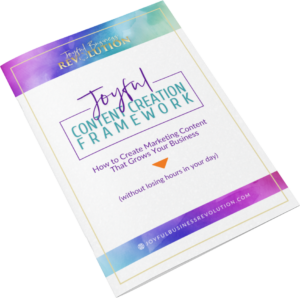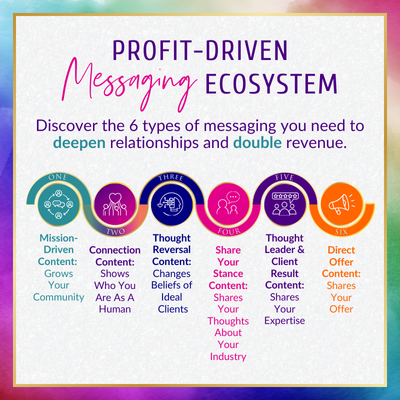What’s the difference between messaging and positioning? If that’s a question you’ve ever asked, you’re in excellent company.
In over 10 years in business, I can tell you that just about every coach, consultant, and expert I’ve worked with has heard the terms messaging and positioning before. However, unless they have a background in marketing, outside of basic definitions that anyone can Google, it’s often tough to turn them into sales.
And candidly, that’s the crux of the matter—how do you define your messaging and positioning and then use them to take action to grow your business?
That’s why when I decided to write a series of six articles about my approach to brand messaging strategy, I knew I needed to tackle messaging vs positioning.
The truth is that messaging and positioning are closely related. While your messaging is how you talk about what you do, positioning relates to what sets you apart in the market.
Of course, there’s more to it than that—so I’m here to share practical tips for defining your messaging and positioning so you can develop an effective marketing strategy for your business.
(Spoiler alert: that includes determining the types of content you need to connect with your audience and nurture those relationships.)
Amy and I created the Content Personality® Club to help business owners like you find joy in email marketing content creation (and provide the accountability to help you get it done). Get the details here.
What is “Messaging” in Marketing?
I touched on this above, but your messaging is how you talk about what you do and how you solve your clients’ problems. It should be a lens for all your marketing efforts, guiding and narrowing down your approach. Even though getting your messaging right can be a lot of work, the concept is quite simple.
What is “Positioning” in Marketing?
On the other hand, positioning focuses on how your products and services differ from your competitors—or anything else on the market. In other words, it’s what makes you stand out.
And because your positioning directly affects how you talk about your business, it’s an integral part of your messaging.
If positioning and messaging sound like two sides of the same coin, in many respects, they are. Especially for small businesses like those owned by coaches, consultants, and experts.
There are plenty of great positioning books out there. However, because most seem to be targeted at mid-size to enterprise-level businesses, unless your service is related to positioning or messaging or you’re intensely interested in the material, reading them may not propel you toward your goals.
With that in mind, I want to offer a word of advice:
Don’t let defining your positioning and messaging become a BD (a big distraction).
It’s far too easy to spend so much time behind the scenes hypothetically thinking about your business and how to create your positioning statement that you completely fail to take action that moves your business forward.
If you’re thinking, “But Shannon—isn’t it important to nail your messaging and positioning? Shouldn’t I spend a great deal of time here?”
The answer is, of course, it matters. But in my mind, it’s a far bigger faux pas to let perfection stand in the way of action. There comes a point when you have to test your messaging and positioning in the wild and see how it resonates with your audience.
From there, it’s a matter of continually iterating and testing until you have the perfect messaging and on-target.
If you’re only thinking and not acting, you won’t make sales. And here’s the thing: even if your first attempt falls flat, you’ve learned something and can adapt your approach and move forward.
Ready to put your messaging and positioning into action? I’ve developed a JOYFUL content creation framework that helps you simplify your content creation process, generate relevant and engaging content consistently, and significantly boost your online visibility and audience engagement. Get the framework here.
Messaging vs Positioning—or Messaging AND Positioning?
By now, you can see how messaging and positioning are tied together. However, if you’re not working at the enterprise level, you may wonder how to find yours without all of the fluff or extra time.
Realistically, your messaging and positioning framework should start with three questions:
- What are your products and services?
- What problem(s) do they solve for your audience?
- What makes your approach, products, and services different from anyone else’s?
The first two questions relate most closely to messaging, while the third speaks more directly to how you position yourself.
In my experience, you have to define your offers and how they help your audience before you can position them or show how they stand out. So, your core messaging should come first.
But know this—even if you land your offer perfectly right out of the gate, your messaging and positioning are not set and forget. I’ve already shared how the best messaging comes from testing and iteration. What’s more, your messaging may change over time for a few reasons, which usually fall into two categories:
#1: Your products and services may shift as your interests change.
I’d be hard-pressed to name a business owner that hasn’t shifted their offers over time. Typically, these are gradual shifts a few times a year that don’t drastically change messaging or positioning with any given shift. However, after 2-4 shifts, their business or audience may have changed enough to revisit things.
#2: The market may shift based on new technologies or economic factors.
Just think about the technological shifts during the pandemic and everything that came after. While the pandemic led to a boom in online businesses, the economic uncertainties in the following years led to a spending hold for businesses of all shapes and sizes, drastically changing demand.
What does this mean for you?
As a coach, consultant, or expert, even though the heart of your business may not change, your products and services probably will. Every business should revisit messaging and positioning every year or so to make sure it’s still on point. Do it sooner if there’s a drastic change in sales or the market.
So, who is responsible for messaging and positioning?
If you’re a solopreneur, all roads lead to you. You can absolutely hire an expert for help but know that smaller teams are more likely than large agencies to understand you and your needs. So if you bring someone in to help, make sure they know how to best serve small businesses like yours—and have a good track record.
If you have a marketing or salesperson, I recommend working closely together to refine your messaging and positioning so that everyone on your team is on the same page.
While you ultimately have the final say, I want you to remember your messaging and positioning is as much about your customer as you. So yes, they should bring you joy and reflect your brand voice—however, they also need to speak to your audience’s needs.
Wondering about your messaging and positioning and how you can use them to grow your business? Set up a call with Amy and she can help you find the best solution.
Signs & Symptoms You Have Messaging and Positioning Problems
By now, you should have a good handle on the importance of positioning and messaging. However, if you’re like most people I work with, that’s only half the battle—you also need to learn how to recognize when your messaging and positioning aren’t working and how to approach the solution.
With that in mind, here are some of the most common issues I see:
The Symptom: People know what you do but don’t buy from you.
Messaging vs. Positioning: Candidly, it could be both.
The Cause: There could be a lot of factors here, so let’s break them down:
People don’t see the value:
- It might be that your messaging doesn’t show your audience why this product will make their lives better.
- If you’re not marketing to the right audience or on the right channels, they’re not going to see the value. Or if you’re not nurturing them enough, they also won’t see the value.
- If you’re not differentiating your offer sufficiently, it’s a positioning problem.
The Solution: Do some work to determine whether you have the right offer, audience, and message. If you’re not making sales, it’s most likely because one is off. Once you know which it is, you can start refining your approach.
Your audience is confused:
- If you talk about your offers (or position them) one way, and the sales page or proposal sends a different message, your audience may not understand what they’re buying.
- You can confuse your audience if you talk about too many vastly different offers instead of one or two themes or categories consistently.
The Solution: Talk to your audience and get their feedback. Then, refine your positioning and messaging, and make sure your sales and marketing materials reflect them. To that end, make sure everyone on your team is talking about things consistently so people expect specific offers or types of offers from you.
The Symptom: Refund requests, chargebacks, or bad reviews.
Messaging vs. Positioning: Positioning
The Cause: There’s a gap between expectation and reality.
The Solution: Ask for feedback on why someone had a bad experience, graciously thank them, and take their feedback into consideration. One or two out of a hundred are probably worth taking with a grain of salt. But if it’s 10% or more, it’s a sign that something’s wrong. More importantly, when people see you’re taking steps to address any problems, you can leave them with a net positive feeling and create more brand loyalty.
The Symptom: Your sales calls are consistently with the wrong people.
Messaging vs. Positioning: Positioning (primarily)
The Cause: People don’t understand what you do or how you can work with them.
The Solution: Find out how they’re finding you and start taking steps to address the narrative through any problematic channels. It could be a big-picture positioning problem that you must address with significant changes to your site and social media, or it could be a matter of minor tweaks.
The Symptom: Poor quality referrals
Messaging vs. Positioning: Probably messaging
The Cause: It’s possible people just don’t understand what you do, even if they want to support you.
The Solution: Reach out to your referral partners, thank them for thinking of you, and help them understand who would be a good referral.
The Symptom: Low email open rates or click rates.
Messaging vs. Positioning: Probably messaging.
The Cause: What you’re sharing is no longer what your audience is interested in. Maybe they joined your list for a freebie and don’t have time or energy to stay in touch.
The Solution: I went into a lot of detail on email nurturing and other strategies for using email to grow your business in my email marketing series. The short answer is to review your metrics and periodically cull people who aren’t engaged from your list.
Of course, there are other signs and symptoms that your messaging and positioning are off. However, if you’re looking for a starting point, this gives you several ideas and fixes.
A Final Word on Creating and Fine Tuning Your Messaging and Positioning
Whether you sell products or services (or a mix), your messaging and positioning should come from the heart and speak to the heart. When it reflects your brand pillars and values, you can attract the right people—because they’ll buy what you stand for.
Then, consistent digital marketing everywhere you show up reinforces your brand identity and creates brand recognition. For example, in my business, that’s primarily through email, social media, and events.
Because your brand messaging should be heartfelt, I strongly feel that AI has no place in your brand—it simply can’t be human. That said, your messaging and positioning don’t have to be creative as long as they’re crystal clear.
The creativity comes when it’s time to start using campaigns to build your audience and nurture your connection to them. And that’s when the fun begins!
Not sure how to best share your marketing and positioning? Our Content Personality® Quiz is designed to help you understand how to use your natural strengths to create marketing content and maximize your time and energy. Take the quiz here!
Frequently Asked Questions About Small Business Messaging & Positioning
What’s the difference between messaging, positioning, and your unique value proposition?
Ultimately, they’re closely tied together. Your messaging is how you talk about your value proposition—or what you do—and your positioning is how you set yourself apart in the marketplace.
What’s the best way to document your company’s messaging & positioning?
There’s no single right way or wrong way. Some people find success in creating a single statement that defines the UVP and audience and uses a statement that explains their expertise. Others find that a one-pager with examples of what you stand for and your voice is more effective. Still, others use bullet points to outline the core message and positioning and messaging for each product and service offered.
I suggest starting simple and going from there to find what works best for you.
Is positioning important for every business, or can some businesses just “wing it”?
Throwing a handful of seeds in the air and hoping something grows isn’t as effective as taking a targeted approach to plant and nurture them. A certain amount of chance is involved, but truly winging it isn’t a good idea because you’ll expend a lot of time, money, and energy.
At a minimum, start by defining what you do, your audience, and why they choose you. With that information, you can start refining and targeting your approach.
How is positioning a physical product different from positioning a service-based product?
There’s a lot of “it depends” in my answer—but the biggest variables are cost, value, and risk for digital and physical product marketing. A $9 product is far easier to sell than a $9,000 one because there’s very little risk, regardless of value. So, while the channels may differ, your product positioning strategy should follow the same steps for physical and digital products.
Do you need to position every product that you sell, or do you position the company as a whole? (I.e., does every product need its own positioning strategy?)
Yes. And by that, I mean “Yes” to both questions. You absolutely need to position the company as a whole—that’s how you build brand recognition, loyalty, and trust. However, you also should position each product—or at least category of products—to ensure you’re communicating what stands out.
Would you like to dive deeper into your messaging–and learn how to use it to attract and nurture your audience?
Be sure to tune into our podcast to get our hot takes on messaging, email marketing, and other topics related to creating a business that brings you joy.
Want to learn more about our take on messaging strategy? Check out all the articles in our messaging series.
Here’s a complete list of the articles in this messaging series:
- Messaging Strategy Demystified (For Coaches, Consultants & Experts Like You)
- Using Brand Messaging Pillars to Guide Your Content
- A Masterclass in Messaging & Positioning for Coaches & Consultants
- Unique Value Proposition (UVP) versus Unique Selling Proposition (USP)
- 197 Brand Adjectives to Describe Your Brand [Sorted by Category]
- Authentic Brand Storytelling. For Everyone.







